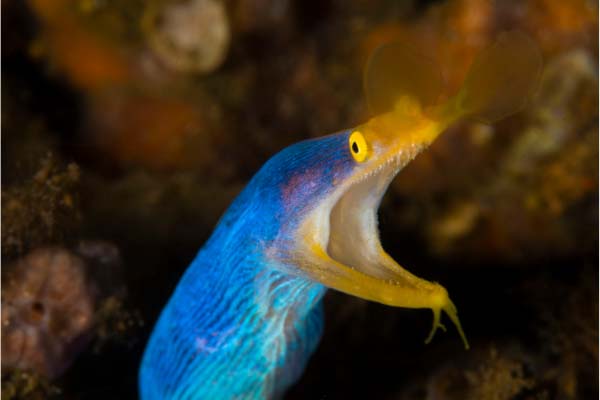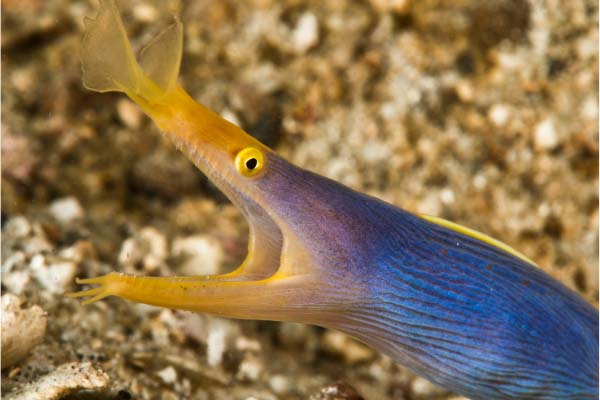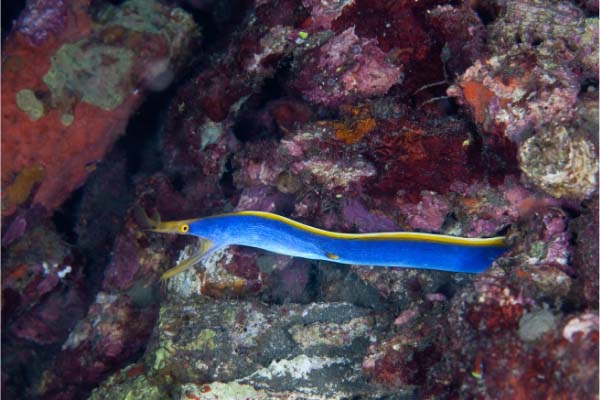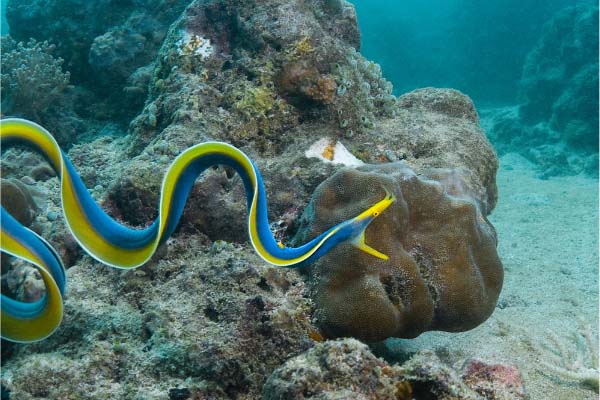[ad_1]
The Ribbon Eel is no doubt, one of the most gorgeous species of Moray Eels out there, don’t you agree? The striking blue and yellow coloration and unmistakable eel-shape attracts many fish lovers. But what does it take to care of them successfully?
Let’s take a closer look at caring for the ribbon eel in a saltwater aquarium.
Table of contents
Quick Facts About the Ribbon Eel:
- Scientific Name: Rhinomuraena quaesita
- Common Names: Blue Ribbon Eel, Back Ribbon Eel
- Max Size: 3-4 feet!
- Minimum tank Size: 75-Gallons
- Aggression Level: Aggressive/predator
- Color: Blue, Yellow, Black
- Care Level: Expert
- Most Active: Day
- Lifespan: ~decades are possible in the wild, unfortunately much less is generally reported in captivity until we find better ways to meet their needs
Natural habitat
This species is most commonly found in the Indo-Pacific ocean. These are bold animals often spotted while scuba diving. They are plentiful in the wild and can often be found poking their heads out of rock awaiting their next meal.
One look at them swimming and you’ll understand where they get their name:
Proper aquarium conditions
Ribbon eels require aquarium water parameters that replicate ocean water quality to be healthy.
Ideal water parameters
- Temperature: ~78-82 Fahrenheit
- Salinity: ~1.023-1.025
- pH: ~8 to 8.2
- Ammonia, Nitrites, Nitrates: as low as you can get them
Learn more about reef aquarium water parameters here.
Learn about creating reef quality water with salt mixes here.
Ribbon eels like lots of live rock to hide in
Can you picture ribbon eels out in the ocean? You would generally find them with their heads poking out from a crevice in live rock, with the rest of their bodies tucked away and concealed within the rock.
Having ample places to hide and navigate between and behind the live rock will ensure your ribbon eel has the right territory to become comfortable and not stressed in your aquarium. Please keep in mind that they require enough space to hide nearly all of their body from sight.
Please also note that if you have a fish wiggling and writing in between your live rock, they may accidentally re-arrange the rock or knockdown pieces as they move, causing collateral damage to corals or other things in your tank that you didn’t want to be crushed by falling rock. A possible solution here is to zip-tie rocks together by drilling holes in the back and unseen parts of the tank (Michael 2019).
A need for tight-fitting lids
Feeding the ribbon eel
Another challenging aspect of caring for these magnificent creatures at home is getting them to eat. The ribbon eel is a notoriously picky predatory carnivore, who prefers to eat small live fish. Even among picky eaters, the ribbon eel has a reputation for being the pickiest (Michael 2019). As you can imagine, this creates certain compatibility issues (when keeping with fish that could be confused as food, not friends) and also makes it difficult to acclimate them to life in captivity.
Watch this ribbon eel hunt down and eat a molly:
It is generally recommended that unless your local fish store can demonstrate that they have been trained to eat small pieces of fish (table food, seafood) from a feeding stick, that you start off by feeding small damselfish, live guppies, or mollies while you begin to train them to take food from the stick. Never feed an eel by hand. they have notoriously bad vision and have particularly painful teeth.

Note the sharp rows of teeth used to shred and hold
Buyer beware. These gorgeous and fascinating creatures often starve to death in captivity. If you do intend to purchase one anyway, please be sure to have a really strong gameplan for feeding live fish and the time and patience to train them to accept other foods.
Scott Michael recommends keeping them first in a smaller tank (about 30 gallons) so that you can more easily keep a high concentration of feeder fish to allow the ribbon eel to eat well and acclimate to life in a home aquarium, and to support the training to take on new foods, before introducing them to the big tank (Michael 2001).
Compatibility
Rule #1: If you have fish or shrimp that will fit into your ribbon eel’s mouth, it may be more compatible with the digestive tract of the eel than with the water surrounding the community reef you created. In case you missed the subtlety there, that means um, your eel may try to eat anything small–that means no small fish, like blue devil damselfish or cleaner shrimp like the fire shrimp.
Therefore the best companions are large, aggressive fish that won’t be tempting to eat. By large, we are talking multiple times too big to fit inside its mouth, right from the start.
It is possible to have more than one eel in a tank. They are reported to be somewhat compatible, as long as you introduce them together are careful to watch out for overt aggression (Michael 2019).
Gender and reproduction
At full maturity and when side-by-side, it is relatively easy to tell female and male ribbon eels apart, because females are significantly larger than males. Ribbon eels are protandric hermaphrodite. Like clownfish, all fish in the species start out as males, and then if there is no female present, the dominant male will undergo a metamorphosis to become female.
Where To Buy
Buying a Ribbon eel can be a complicated process as some fish stores just don’t want to deal with them. If you do find one sold at a store, make sure to inquire about what they feed it and ask to see it eat. Don’t be surprised to find out a shop imported one of these eels and hasn’t been able to get it eating in their set-up. You should also note that this is an expensive fish to buy. The price of this species commonly goes above the $100 threshold.
While this can net you free shipping when buying for a store online. The challenge in keeping these fish alive is likely part of the charm, at this point in your exploration, but just be warned that it may end up being a major frustration for you.
For more information
Check out this video to learn more about caring for the ribbon eel:
If you are looking for an easier-to-care for eel species, check out the Snowflake eel
or other predatory fish like dwarf lionfish, or the large Dogface pufferfish.
Whether to Buy a Ribbon Eel or Not
If you would consider yourself anything other than an advanced reef-keeper, with a lot of patience and the ability to feed live fish (in high enough densities your eel can capture an easy meal, you should probably NOT buy a ribbon eel. I don’t want to come across as sounding judgey or preachy, but from the research that went into this article, they are a handful to care for.
With that said, if predator tanks are your thing, and you have success getting some picky eaters to eat, they might just be the most attractive fish in your tank–and we all might learn a thing or two from your efforts if you share those efforts.
References:
Michael, Scott W. Marine Fishes: 500+ Essential-to-Know Aquarium Species. T.F.H. Publications. Neptune City, NJ 2001.
Michael, Scott W. “Moray Madness”. Coral, The Reef & Marine Aquarium Magazine: May/June 2019 Issue.
[ad_2]
Source link






